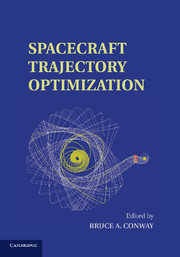Book contents
- Frontmatter
- Contents
- Preface
- 1 The Problem of Spacecraft Trajectory Optimization
- 2 Primer Vector Theory and Applications
- 3 Spacecraft Trajectory Optimization Using Direct Transcription and Nonlinear Programming
- 4 Elements of a Software System for Spacecraft Trajectory Optimization
- 5 Low-Thrust Trajectory Optimization Using Orbital Averaging and Control Parameterization
- 6 Analytic Representations of Optimal Low-Thrust Transfer in Circular Orbit
- 7 Global Optimization and Space Pruning for Spacecraft Trajectory Design
- 8 Incremental Techniques for Global Space Trajectory Design
- 9 Optimal Low-Thrust Trajectories Using Stable Manifolds
- 10 Swarming Theory Applied to Space Trajectory Optimization
- Index
- References
7 - Global Optimization and Space Pruning for Spacecraft Trajectory Design
Published online by Cambridge University Press: 06 December 2010
- Frontmatter
- Contents
- Preface
- 1 The Problem of Spacecraft Trajectory Optimization
- 2 Primer Vector Theory and Applications
- 3 Spacecraft Trajectory Optimization Using Direct Transcription and Nonlinear Programming
- 4 Elements of a Software System for Spacecraft Trajectory Optimization
- 5 Low-Thrust Trajectory Optimization Using Orbital Averaging and Control Parameterization
- 6 Analytic Representations of Optimal Low-Thrust Transfer in Circular Orbit
- 7 Global Optimization and Space Pruning for Spacecraft Trajectory Design
- 8 Incremental Techniques for Global Space Trajectory Design
- 9 Optimal Low-Thrust Trajectories Using Stable Manifolds
- 10 Swarming Theory Applied to Space Trajectory Optimization
- Index
- References
Summary
Introduction
Global optimization algorithms and space pruning methods represent a recent new paradigm for spacecraft trajectory design. They promise an automated and unbiased search of different trajectory options, freeing the final user from the need for caring about implementation details. In this chapter we provide a unified framework for the definition of trajectory problems as pure mathematical optimization problems highlighting their common nature. We then present the detailed definition of two popular typologies, the Multiple Gravity Assist (MGA) and the Multiple Gravity Assist with single Deep Space Manouver (MGA-1DSM). Later we describe in detail the instantiation of four particular problems proposing them as a test set to benchmark the performances of different algorithms and pruning solutions. We take inspiration from real interplanetary trajectories such as Cassini, Rosetta, and the proposed TandEM mission, considering a large search space in terms of possible launch windows and transfer times, but also from rather academic cases such as that of the First Global Trajectory Optimisation Competition (GTOC). We test four popular heuristic paradigms on these problems (differential evolution, particle swarm optimization, simulated annealing with adaptive neighborhood, and genetic algorithm) and note their poor performances both in terms of reliability and solution quality, arguing for the need to use more sophisticated approaches, for example, pruning methods, to allow finding better trajectories. We then introduce the cluster pruning method for the MGA-1DSM problem and we apply it, in combination with the simulated annealing with adaptive neighborhood algorithm, to the TandEM test problem finding a large number of good solutions and a new putative global optima.
- Type
- Chapter
- Information
- Spacecraft Trajectory Optimization , pp. 178 - 201Publisher: Cambridge University PressPrint publication year: 2010
References
- 35
- Cited by

